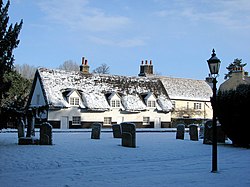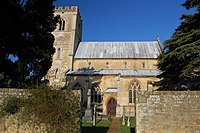Trumpington
| Trumpington | |
| Cambridgeshire | |
|---|---|
 Cottages in the snow, Trumpington | |
| Location | |
| Grid reference: | TL442549 |
| Location: | 52°10’26"N, 0°6’32"E |
| Data | |
| Post town: | Cambridge |
| Postcode: | CB2 |
| Dialling code: | 01223 |
| Local Government | |
| Council: | Cambridge |
| Parliamentary constituency: |
Cambridge |
Trumpington is a village in Cambridgeshire, on the outskirts of Cambridge. It is to be found on the southwest side of the city, the old village sitting on the east bank of the River Granta, with a bridge here leading to Grantchester on the eat bank..The newer developments of the parish, which to say of the nineteenth century, stretched out away from the village and along the Trumpington Road toward the City of Cambridge, and these parts have effectively become part of the city.
Great Shelford and Little Shelford are found the southeast.
Contents
Parish church
There was a church in the village by the start of the 13th century. Parts of the present church, dedicated to St Mary and St Michael, date from the mid-13th century and the nave was rebuilt in the 14th century.[1]
The parish church is the resting place of Henry Fawcett, the blind academic and politician who, as Postmaster General (1880-1884), introduced parcel post, postal orders and other innovations. The primary school is named Fawcett School after him. The church also contains the monumental brass of Sir Roger de Trumpington, a crusader knight bearing the date 1289; it is said to be the second oldest brass in Britain.[2]
History
There is evidence of Iron Age and Roman settlements in Trumpington, near the River Cam ford by the road to Grantchester, and a Roman cemetery. An Anglo-Saxon cemetery has also been found nearby at Dam Hill.[1]
By 1086 there was a thriving community of 33 peasants at the time of the Domesday Book, and the population had risen to 100 by the late 13th century. The village remained sizeable throughout the Middle Ages and by 1801 there were 494 residents. Until the 20th century Trumpington was an agricultural village with cattle and sheep as well as crops. [3]
Trumpington's association with agriculture was extended further in 1955, when the Plant Breeding Institute (PBI) – founded in 1912 as part of the University of Cambridge's School of Agriculture – moved to the Anstey Hall site adjoining Maris Lane in Trumpington. Here the PBI developed new plants, notably potatoes called Maris Piper and Maris Peer, a barley called Maris Otter, and a wheat called Maris Wigeon. These are now in use worldwide. In 1990 the PBI relocated to Colney, near Norwich, but the reference to the Maris Lane site survives in the names of plants.
Anstey Hall is a former country house built c.1700 within its own parkland. Once owned by writer and poet Christopher Anstey and later by the polymath Robert Leslie Ellis, it was leased to the PBI for many years. It is now used for weddings, parties, corporate events and meetings.
The war memorial in the village was designed and carved by Eric Gill, who also designed and carved the crocodile on the wall of the Cavendish Laboratory. [4] The memorial was dedicated on Sunday 11 December 1921 to commemorate 36 Trumpington men who died in the First World War. The Second World War claimed eight more local men; their names were added by David Kindersley, a pupil of Gill's.
Trumpington Fair
In 1314, the lord of the manor, Giles of Trumpington, was given permission to hold a three-day fair on the feast of St Peter's Chains (1 August). The feast was still held in the 19th century though was transferred to June 28-30, and became known for the rowdiness and drunkenness of its many visitors. It was reduced to only one day (29 June) in 1882 and was still held in the 1930s.[1]
"Southern Fringe" developments
Cambridge City Council's 2006 Local Plan provided for the release of an extensive area of Green Belt land around Trumpington for new housing and associated community facilities. Major new developments are being constructed on the Glebe Farm and Clay Farm sites to the south and east of the village, and on Trumpington Meadows to the southwest.
Trumpington bed burial
In 2012 archaeologists working on the Trumpington Meadows site discovered a 7th-century Anglo-Saxon bed burial for a young woman aged about 16 years old, in a field on the outskirts of the village. The occupant of the grave had been buried on a wooden bed, and had an ornate gold pectoral cross inlaid with garnets on her breast. The jewelled gold cross is very unusual, and can only have belonged to a member of a rich aristocratic family. It is thought that the grave must have been associated with a hitherto unknown Anglo-Saxon settlement near the site, perhaps that of a monastic community.[5]
Chaucer and the Miller of Trumpington
In Chaucer's Canterbury Tales, The Reeve's Tale is set in Trumpington, and a water mill on the Cam is mentioned in it. The location of the mill is believed to be Old Mill Holt on the river to the southwest of the village.[1]
The Miller of Trumpington is a rough fellow in the tale, perhaps intended for the Reeve to rebuke the Miller who tells a crude story in the Miller's Tale.
Outside links
References
- ↑ 1.0 1.1 1.2 1.3 Victoria County History: A History of the County of Cambridge and the Isle of Ely
- ↑ Information on Trumpington from GENUKI
- ↑ Trumpington Residents’ Association
- ↑ [http://www.phy.cam.ac.uk/history/years/croc.php Department of Physics, Cavendish Laboratory, 100 Years and more
- ↑ Kennedy, Maev (16 March 2012). "Cross and bed found in Anglo-Saxon grave shed new light on 'dark ages'". The Guardian. http://www.guardian.co.uk/science/2012/mar/16/cross-bed-anglo-saxon-grave.

